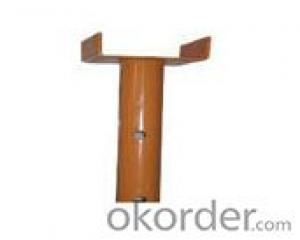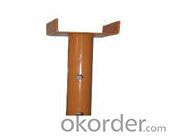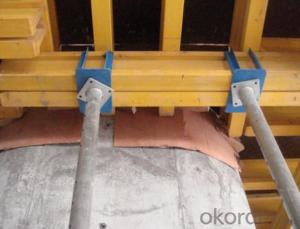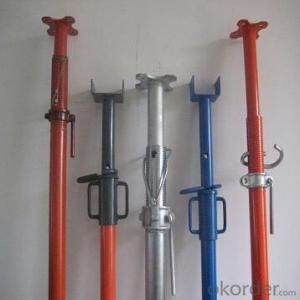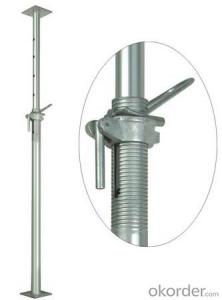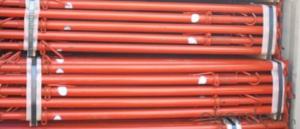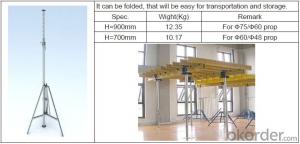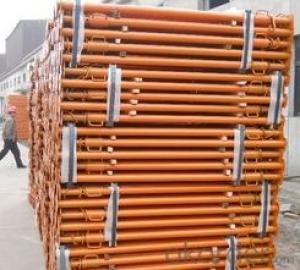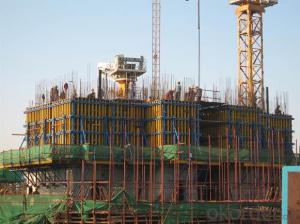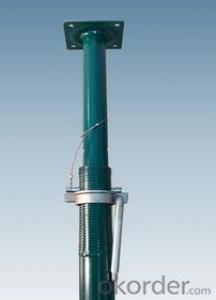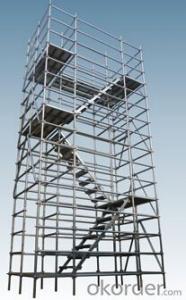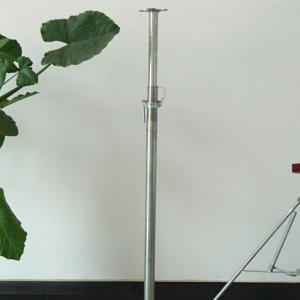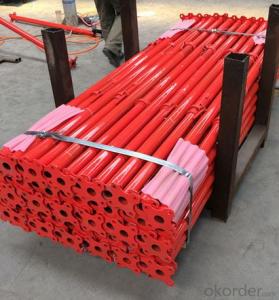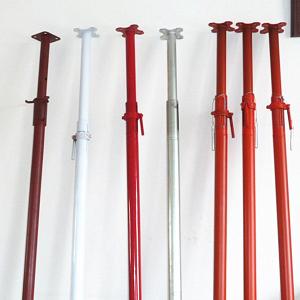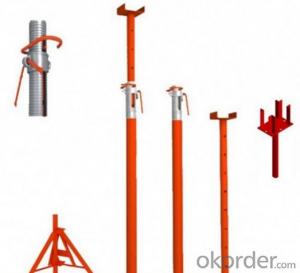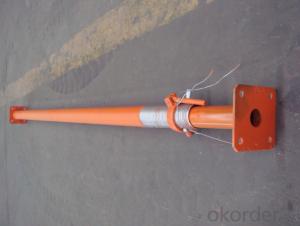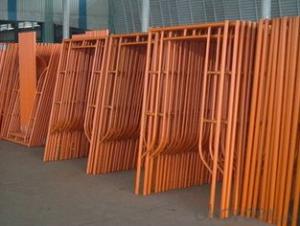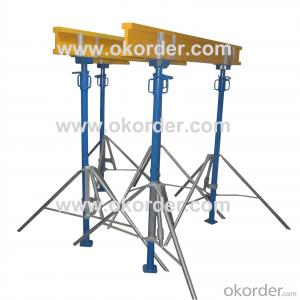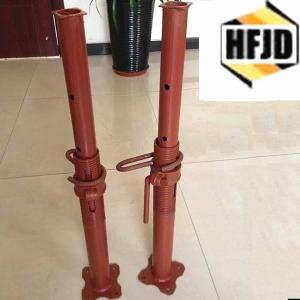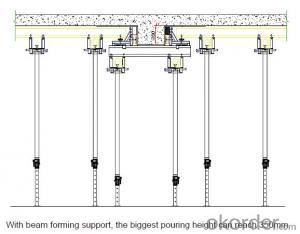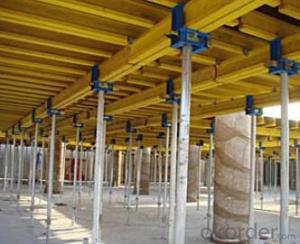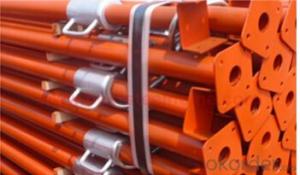straight lock pin 2.2-3.9m shoring prop scaffolding supporting concrete
- Loading Port:
- Tianjin
- Payment Terms:
- TT OR LC
- Min Order Qty:
- 10000 pc
- Supply Capability:
- 10000 pc/month
OKorder Service Pledge
OKorder Financial Service
You Might Also Like
Quick Details
| Brand Name: | ADTO | Model Number: | shoring props | ||
| Type: | Scaffolding Parts,Heavy duty/ Light duty | Scaffolding Part Type: | Scaffolding Props | Material: | Q235 /Q345 steel |
| Surface: | pre-galvanized, hot dipped galvanized, painted | Certification: | ISO9001:2000 | Nut: | Casting type/ Cup type |
| Adjustable range: | .8-3.1m/2.0-3.6m/2.2-4.0m/2.5-4.0m/3.0-4.8m | Test: | SGS TUV BV |
| Brand Name: | ADTO | Model Number: | shoring props | ||
| Type: | Scaffolding Parts,Heavy duty/ Light duty | Scaffolding Part Type: | Scaffolding Props | Material: | Q235 /Q345 steel |
| Surface: | pre-galvanized, hot dipped galvanized, painted | Certification: | ISO9001:2000 | Nut: | Casting type/ Cup type |
| Adjustable range: | .8-3.1m/2.0-3.6m/2.2-4.0m/2.5-4.0m/3.0-4.8m | Test: | SGS TUV BV |
Product Description
Details of scaffolding shoring props
1.Common height range(closed-extended): 1.6 -2.9m ; 1.7 -3.0m ; 1.8-3.2m ; 2.0-3.6m ; 2.2-4.0m ; 2.4-3.9m ; 2.5-4.5m ; 2.6-5.0m ; 3.0-5.0m ; 3.2-6.0m
2.Diameter range on tube ( inner /outer): 40/48mm ; 48/56mm ; 48/60mm
3.Thickness range on tube: 1.6mm; 1.85mm; 2.0mm; 2.5mm; 3.0mm
4.Type: Heavy duty scaffolding prop/light duty scaffolding prop
5.Surface finish: painted, pre-galvanized, hot dip galvanized
6.We can provide all kinds of scaffolding props with high quality at low price
7.Material: Q235 for welded pipe and 20# for seamless pipe
8.Produced in our own factory,can control the quality much better
9.Samples are available
10.ISO 9001-2000 approved.
11.Performance:good bearing capacity,durable & stable
12.Test: SGS, BV or as per your request
13.OEM service is available.
- Q: Can steel props be used in the construction of water treatment plants or reservoirs?
- Yes, steel props can be used in the construction of water treatment plants or reservoirs. Steel props are commonly used in construction projects to provide temporary support to structures, and they can be utilized in the construction of water treatment plants or reservoirs to support temporary structures, such as formwork or scaffolding. However, it is important to consider the specific requirements and conditions of the project, as well as any regulations or guidelines pertaining to the use of steel props in water-related structures.
- Q: Are steel props suitable for supporting beams?
- Supporting beams can be effectively done using steel props. These props, also referred to as adjustable steel props or acrow props, are widely used in construction projects to provide temporary support for beams, walls, and ceilings. They are constructed from high-quality steel and have adjustable lengths, enabling them to offer dependable and sturdy support for different load-bearing structures. Steel props possess exceptional durability and a strong load-bearing capacity, making them suitable for supporting heavy beams. They are designed to endure substantial weights and pressures without collapsing or buckling. Furthermore, their adjustable height feature allows for easy customization to meet the specific requirements of any project. In addition, steel props exhibit flexibility and can be effortlessly installed, adjusted, and removed as necessary. They establish a stable and secure temporary support system during construction, renovation, or repair work, ensuring the safety of workers and preventing any structural damage. In conclusion, steel props are a trustworthy option for supporting beams due to their strength, durability, adjustability, and user-friendly nature.
- Q: Are there any regulations or standards for using steel props?
- Regulations and standards exist for the use of steel props in the construction and engineering industries. Steel props, also called adjustable steel props or scaffolding props, are temporary support structures utilized for vertical support during construction or renovation activities. Various countries have building codes and safety standards that govern the use of steel props. These regulations guarantee that steel props are designed, manufactured, and utilized in a safe and efficient manner. While the specific regulations and standards may differ across jurisdictions, they generally encompass different aspects of steel prop usage, such as design criteria, load capacities, installation methods, and inspection requirements. An example of such regulations is the British Standard BS 4074, which specifies the criteria for adjustable steel props used in construction. It outlines manufacturing requirements, load capacities, safety factors, as well as guidelines for proper installation, bracing, and inspection procedures. Similarly, in the United States, the Occupational Safety and Health Administration (OSHA) sets standards for construction activities, including the use of steel props. OSHA regulations, like 29 CFR 1926 Subpart L, provide guidelines on scaffold use, including appropriate design, erection, and dismantling procedures for scaffolding systems, which may incorporate steel props. These regulations and standards are in place to ensure the safety of workers and the general public during construction activities. Their aim is to prevent accidents, collapses, and injuries resulting from faulty or improper use of steel props. Compliance with these regulations is typically mandatory and enforced by regulatory authorities, who may conduct inspections and issue penalties for non-compliance. Therefore, it is crucial for construction companies, contractors, and individuals involved in construction projects to be aware of and adhere to the applicable regulations and standards in their jurisdiction. They should ensure that the steel props used on their sites meet the necessary requirements, are correctly installed, and undergo regular inspections to ensure their integrity and safety.
- Q: How do you calculate the load capacity of a steel prop?
- To calculate the load capacity of a steel prop, you need to consider several factors. First, determine the allowable stress for the steel prop material. Then, measure the dimensions of the prop, including its length, diameter, and thickness. Next, calculate the cross-sectional area of the prop. Multiply this area by the allowable stress to obtain the maximum load capacity. Additionally, take into account any additional factors like safety margins, environmental conditions, and the type of load being supported to ensure accurate calculations.
- Q: Are steel props suitable for supporting temporary walls or partitions?
- Yes, steel props are suitable for supporting temporary walls or partitions. Steel props are sturdy and adjustable, allowing them to provide strong support and stability for temporary structures. They are commonly used in construction and event industries to support walls, partitions, and other temporary structures.
- Q: Can steel props be used for supporting temporary outdoor stages or performance venues?
- Yes, steel props can be used for supporting temporary outdoor stages or performance venues. Steel props are commonly used in construction and provide strong and stable support for various structures. They are designed to withstand heavy loads and can be adjusted to the desired height and angle. When used for supporting temporary outdoor stages or performance venues, steel props can help ensure the safety and stability of the structure, especially in areas with unpredictable weather conditions or uneven ground. Additionally, steel props are versatile and can be easily installed and dismantled, making them ideal for temporary setups. However, it is important to consult with a structural engineer or a professional in the field to ensure that the steel props are properly selected and used according to the specific requirements of the stage or venue.
- Q: Are steel props resistant to fire and heat?
- Fire and heat generally do not affect steel props, although their effectiveness may differ based on the grade and thickness of the steel. Steel possesses natural fire resistance and a high melting point, which reduces its susceptibility to extreme temperatures. Nevertheless, prolonged exposure to intense heat can compromise the structural integrity of steel. It is crucial to understand that steel props are not fireproof and, therefore, should not be relied upon indefinitely in the event of a fire. In such circumstances, it is imperative to promptly adhere to established safety measures and evacuate the premises.
- Q: Are steel props easy to install and dismantle?
- Generally, steel props are easy to install and dismantle. They are commonly used in construction projects to support temporary structures like scaffolding or formwork. When installing them, they are positioned and their height is adjusted according to project requirements. Most steel props have an adjustable mechanism for easy height adjustment, making it convenient for different construction needs. Similarly, dismantling steel props is typically straightforward. After the temporary structure is no longer needed, the props can be easily removed by reversing the installation process. This involves lowering the props, releasing any locking mechanisms, and removing them from their positions. Moreover, steel props are often designed with lightweight materials like aluminum or steel alloy, enhancing their portability and ease of handling. This allows construction workers to install, adjust, and dismantle them with ease, saving time and effort during construction or renovation projects. However, it's important to note that the ease of installation and dismantling may vary depending on the specific design and manufacturer of the steel props. Proper training and adherence to safety guidelines are crucial to ensure correct installation and dismantling procedures are followed, minimizing potential risks or accidents.
- Q: Are steel props suitable for supporting temporary stages?
- Yes, steel props are suitable for supporting temporary stages. Steel props, also known as adjustable steel props or steel acrow props, are commonly used in construction and temporary structures to provide support and stability. Steel props are made of robust steel tubes and have a telescopic design, allowing for easy height adjustment to suit different stage heights. They are known for their strength and durability, making them suitable for supporting heavy loads, such as stage platforms, equipment, and performers. Furthermore, steel props are easy to set up and dismantle, making them a convenient choice for temporary stages that require frequent assembly and disassembly. They can be quickly adjusted to the desired height and locked in place securely, providing a stable and reliable support structure. Additionally, steel props offer great load-bearing capacity, ensuring the safety of the stage and everyone on it. They can withstand significant weight and pressure, making them suitable for various stage setups, including large-scale productions or events with multiple performers. Overall, steel props are a reliable and suitable choice for supporting temporary stages. Their strength, durability, adjustability, and load-bearing capacity make them an ideal option for ensuring the stability and safety of the stage and its components.
- Q: Can steel props be used in the construction of residential buildings?
- Yes, steel props can be used in the construction of residential buildings. Steel props provide temporary support during construction and can be adjusted to suit the specific requirements of the project. They are commonly used for supporting beams, walls, and slabs, ensuring stability and safety during the construction process.
Send your message to us
straight lock pin 2.2-3.9m shoring prop scaffolding supporting concrete
- Loading Port:
- Tianjin
- Payment Terms:
- TT OR LC
- Min Order Qty:
- 10000 pc
- Supply Capability:
- 10000 pc/month
OKorder Service Pledge
OKorder Financial Service
Similar products
Hot products
Hot Searches
Related keywords
